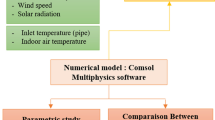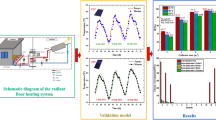Abstract
In the building with many transparent envelopes, solar radiation can irradiate on the local surface of floor and cause overheating. The local thermal comfort in the room will be dissatisfactory and the thermal performance of radiant floor will be strongly affected. However, in many current calculation models, solar radiation on the floor surface is assumed to be uniformly distributed, resulting in the inaccurate evaluation of the thermal performance of the radiant floor. In this paper, a calculation model based on the theory of discretization and the RC thermal network is proposed to calculate the dynamic thermal performance of radiant floor with the consideration of unevenly distributed solar radiation. Then, the discretization model is experimentally validated and is used to simulate a radiant floor heating system of an office room in Lhasa. It is found that with the unevenly distributed solar radiation, the maximum surface temperature near the south exterior window can reach up to 35.6 °C, which exceeds the comfort temperature limit and is nearly 8.5 °C higher than that in the north zone. Meanwhile, the heating capacity of the radiant floor in the irradiated zone can reach up to 171 W/m2, while that in the shaded zone is only 79 W/m2. The model with the assumption of uniformly distributed solar radiation ignores the differences between the south and north zones and fails to describe local overheating in the irradiated zones. By contrast, the discretization model can more accurately evaluate the thermal performance of radiant floor with the influence of real solar radiation. Based on this discretization model, novel design and control schemes of radiant floor heating system can be proposed to alleviate local overheating and reduce heating capacity in the irradiated zone.
Similar content being viewed by others
References
Athienitis AK (1997). Investigation of thermal performance of a passive solar building with floor radiant heating. Solar Energy, 61: 337–345.
Athienitis AK, Chen Y (2000). The effect of solar radiation on dynamic thermal performance of floor heating systems. Solar Energy, 69: 229–237.
Babiak J, Olesen B W, Petrás D (2007). REHVA Guidebook No 7: Low Temperature Heating and High Temperature Cooling. Brussels: REHVA.
Beckman WA, Duffie JA (2013). Solar Engineering of Thermal Processes, 4th end. Hoboken, NJ, USA: John Wiley & Sons.
DBJ540001 (2016). Design Standard for Energy Efficiency of Civil Buildings in Tibet. (in Chinese)
De Carli M, Tonon M (2011). Effect of modelling solar radiation on the cooling performance of radiant floors. Solar Energy, 85: 689–712.
De Carli M, Scarpa M, Tomasi R, et al. (2012). DIGITHON: A numerical model for the thermal balance of rooms equipped with radiant systems. Building and Environment, 57: 126–144.
DOE (2020). EnergyPlus Version 9.3.0 Documentation: Engineering Reference. U.S. Department of Energy (DOE).
EN 15377–1 (2005). Heating Systems in Buildings. Design of Embedded Water Based Surface Heating and Cooling Systems. Part 1. Determination of the design heating and cooling capacity.
Fazenda PV (2016). Context-based thermodynamic modeling and optimal management of energy and occupant comfort for building spaces. PhD Thesis, Universidade de Lisboa, Portugal.
Feng JD, Schiavon S, Bauman F (2016). New method for the design of radiant floor cooling systems with solar radiation. Energy and Buildings, 125: 9–18.
Fraisse G, Viardot C, Lafabrie O, et al. (2002). Development of a simplified and accurate building model based on electrical analogy. Energy and Buildings, 34: 1017–1031.
GB 50736 (2012). Design Code for Heating Ventilation and Air Conditioning of Civil Buildings. (in Chinese)
Huang L, Kang J (2021). Thermal comfort in winter incorporating solar radiation effects at high altitudes and performance of improved passive solar design—Case of Lhasa. Building Simulation, 14: 1633–1650.
Koschenz M, Dorer V (1999). Interaction of an air system with concrete core conditioning. Energy and Buildings, 30: 139–145.
Koschenz M, Lehmann B (2000). Thermoaktive Bauteilsysteme Tabs. Zurikh: EMPA Energie systeme/Haustechnik. (in German)
Li Q, Chen C, Zhang Y, et al. (2014). Simplified thermal calculation method for floor structure in radiant floor cooling system. Energy and Buildings, 74: 182–190.
Li A, Sun Y, Xu X (2017). Development of a simplified resistance and capacitance (RC)-network model for pipe-embedded concrete radiant floors. Energy and Buildings, 150: 353–375.
Li T, Merabtine A, Lachi M, et al. (2021). Experimental study on the thermal comfort in the room equipped with a radiant floor heating system exposed to direct solar radiation. Energy, 230: 120800.
Liu Z, Wu D, Yu H, et al. (2018). Field measurement and numerical simulation of combined solar heating operation modes for domestic buildings based on the Qinghai-Tibetan Plateau case. Energy and Buildings, 167: 312–321.
Liu Z, Wu D, He B, et al. (2019). Evaluating potentials of passive solar heating renovation for the energy poverty alleviation of plateau areas in developing countries: A case study in rural Qinghai-Tibet Plateau, China. Solar Energy, 187: 95–107.
Liu Y, Yu Z, Song C, et al. (2022). Heating load reduction characteristics of passive solar buildings in Tibet, China. Building Simulation, 15: 975–994.
MOHURD (2020). Report on China Building Energy Efficiency. Ministry of Housing and Urban-Rural Development of China (MOHURD). Beijing: China Architecture & Building Press. (in Chinese)
National Meteorological Information Center of China (2005). Meteorological Data Set for Building Thermal Environment Analysis of China. Beijing: China Architecture & Building Press. (in Chinese)
Olesen BW (2002) Radiant floor heating in theory and practice. ASHRAE Journal, 44(7): 19.
Ralegaonkar RV, Gupta R (2010). Review of intelligent building construction: A passive solar architecture approach. Renewable and Sustainable Energy Reviews, 14: 2238–2242.
Si P, Lv Y, Rong X, et al. (2020). An innovative building envelope with variable thermal performance for passive heating systems. Applied Energy, 269: 115175.
Tang H, Zhang T, Liu X, et al. (2018). Novel method for the design of radiant floor cooling systems through homogenizing spatial solar radiation distribution. Solar Energy, 170: 885–895.
Tang H, Zhang T, Liu X, et al. (2020). A novel approximate harmonic method for the dynamic cooling capacity prediction of radiant slab floors with time variable solar radiation. Energy and Buildings, 223: 110117.
Zhao K, Liu X, Jiang Y (2013). Application of radiant floor cooling in a large open space building with high-intensity solar radiation. Energy and Buildings, 66: 246–257.
Zhao K, Liu X, Jiang Y (2014a). On-site measured performance of a radiant floor cooling/heating system in Xi’an Xianyang International Airport. Solar Energy, 108: 274–286.
Zhao K, Liu X, Jiang Y (2014b). Dynamic performance of water-based radiant floors during start-up and high-intensity solar radiation. Solar Energy, 101: 232–244.
Zhu Q, Xu X, Gao J, et al. (2015). A semi-dynamic model of active pipe-embedded building envelope for thermal performance evaluation. International Journal of Thermal Sciences, 88: 170–179.
Acknowledgements
This research work was financially supported by the Natural Science Foundation of Sichuan Province (No. 2022NSFSC1944) and the National Natural Science Foundation of China (No. 51708453).
Author information
Authors and Affiliations
Contributions
All authors contributed to the study conception and design. Simulation calculation, data analysis and results presentation were performed by Jiacheng Zheng, Tao Yu and Bo Lei. The first draft of the manuscript was written by Jiacheng Zheng and all authors commented on previous versions of the manuscript. All authors read and approved the final manuscript.
Corresponding author
Additional information
Declaration of competing interest
The authors have no competing interests to declare that are relevant to the content of this article.
Rights and permissions
About this article
Cite this article
Zheng, J., Yu, T., Lei, B. et al. Evaluation of the thermal performance of radiant floor heating system with the influence of unevenly distributed solar radiation based on the theory of discretization. Build. Simul. 16, 105–120 (2023). https://doi.org/10.1007/s12273-022-0928-6
Received:
Revised:
Accepted:
Published:
Issue Date:
DOI: https://doi.org/10.1007/s12273-022-0928-6




